EdTech
Top Use Cases of Voice Technology in Education
January 29, 2025 • 180 Views • 18 min read
Bohdan Vasylkiv
CEO & Co-Founder
Both voice AI technology and the EdTech industry are gaining popularity. Today, we would like to discuss their combination and the potential of voice technology in Education, as well as how it can impact this industry.
However, before examining such drastic changes, we must explain some basics, like technology, its examples, benefits, and challenges.
The Rise of Voice Technology in Edtech
Long story short, voice AI technology has already existed for some time. However, it was primarily affordable to tech giants like Google, Amazon, and Apple. The reason is simple: developing and maintaining such solutions is a complex, time-consuming, and resource-intensive process.
Nevertheless, after the artificial intelligence revolution and the emergence of open-source AI technologies like ChatGPT and other OpenAI products, EdTech software development companies gained the possibility to enable such functionality in new projects.
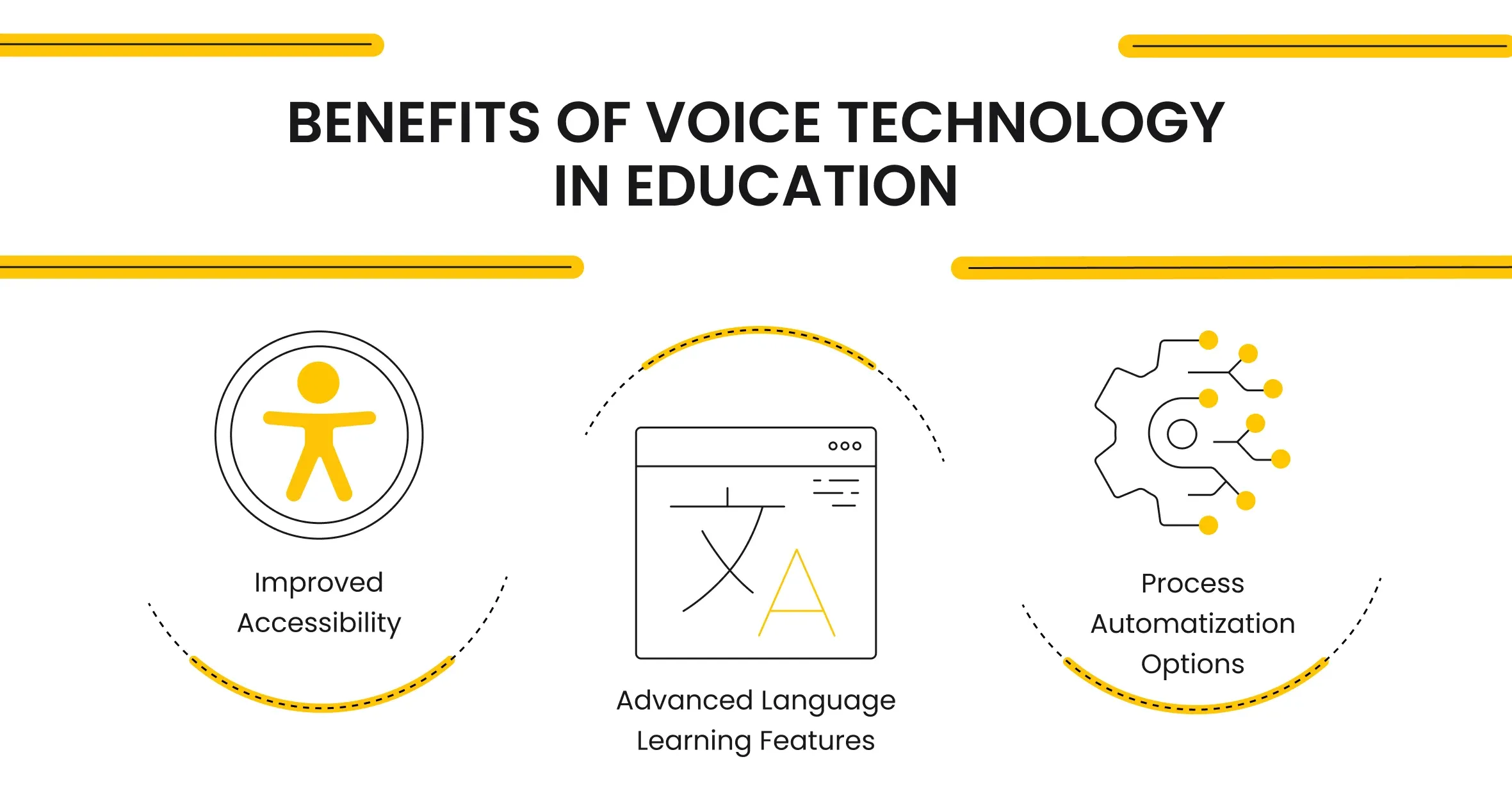
Such market change also made tech giants join the race. For instance, Google offers its Speech-to-Text AI as a software-as-a-service solution. As a result, the modern voice technology market suggests multiple options, allowing eLearning platforms to choose the best and most suited software to satisfy their needs.
Such advantageous conditions impacted multiple fields and industries, boosting and driving the popularity of different artificial intelligence integrations, including general or voice AI technology popularization, and EdTech is no exception.
For example, according to the IMARC Group, the global AI in education market reached 4.8 billion US dollars in 2024 and is expected to grow to 75.1 billion dollars by 2033. The reasons for such drastic growth can be easily explained by examining the core benefits and use cases of voice technology in Education.
Examples of Voice Technology in Education
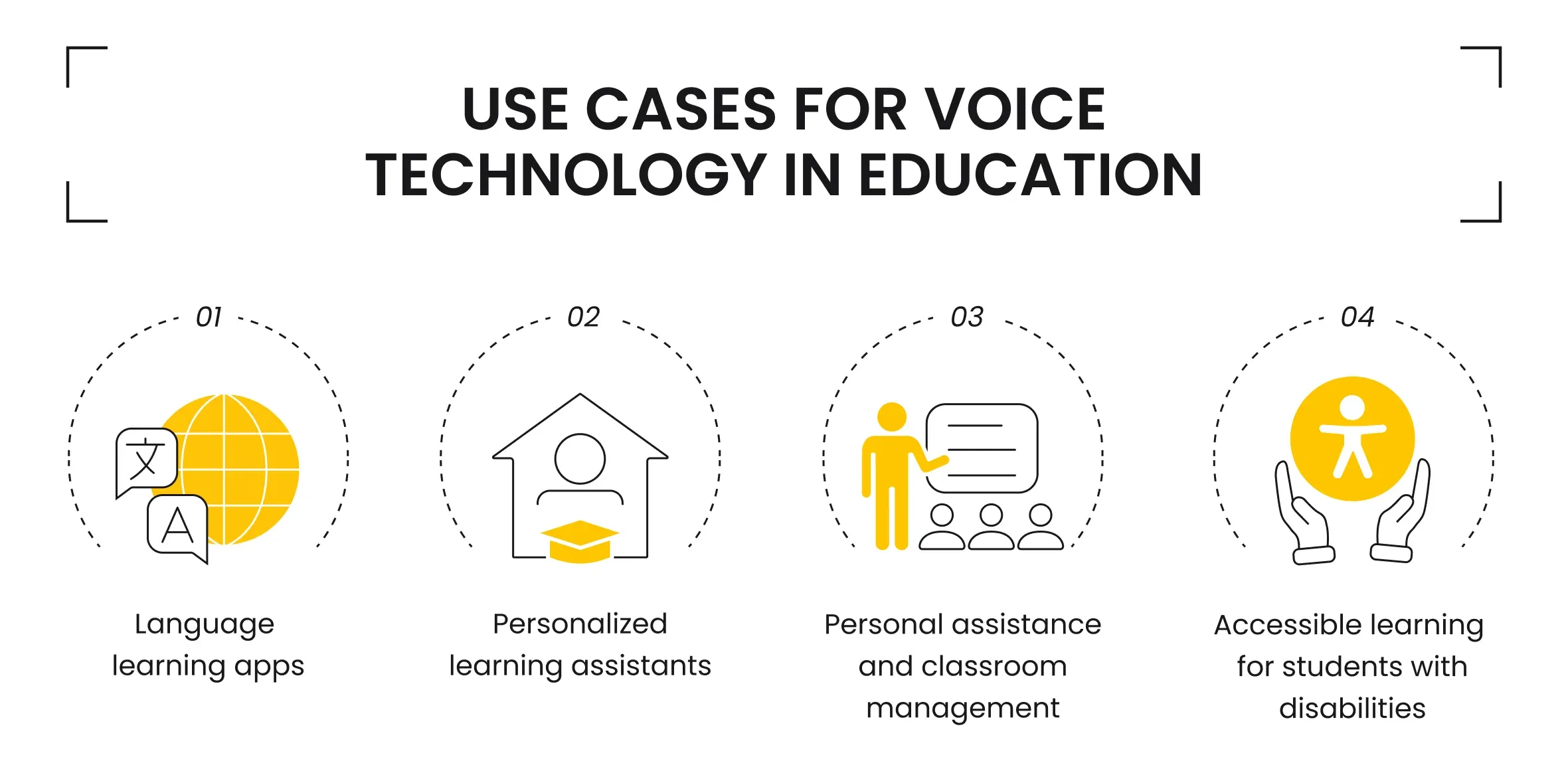
The number of possible use cases for general AI in eLearning is almost countless and is mainly limited by your imagination. Yet, if we talk about voice technology in Education, it is possible to highlight a few core benefits and use cases for such software instruments:
- Language learning apps
- Personalized learning assistants
- Personal assistance and classroom management
- Accessible learning for students with disabilities
Language Learning Apps
One of the most obvious and prominent reasons for integrating such AI in education platforms is speech recognition software for language learning.
Frankly, just a few years ago, learning or advancing your language skills was a challenging task that commonly required at least part-time communication with native speakers. While most aspects like grammar or vocabulary could be quickly learned online, practicing pronunciation was impossible without conversing with tutors or natives.
Fortunately, STT systems integration in eLearning platforms can cover this aspect. For instance, Whisper AI can be fine-tuned to distinguish accents and other language specifics. Yet, finding other examples of voice AI technology that offers even more advanced services is also possible.
For instance, Duolingo has been using a custom STT system for some time, testing and grading the students’ pronunciation. Long story short, speech recognition software for language learning is an excellent idea worth implementing. Besides, modern technologies are already capable of such processes.
Personalized Learning Assistants
Speech-to-text technology in the classroom can also work as a personalized virtual assistant. For example, solutions like Google speech-to-text services can even distinguish different speakers.
So, it can be used for making automated notes and class transcription, saving students time and effort for writing down the course and paying more attention to the teacher’s words or examples instead.
Don’t also forget about the valuable features of various AI solutions. Such AI models as ChatGPT are designed to give a detailed answer to any question or user request. To simplify, most AI products are vast databases with processed data. So they can easily and quickly give you a detailed response on any topic they have information about.
In fact, there are many guides and examples of how people started using ChatGPT as a personal tutor with some simple prompt engineering. Imagine how your eLearning platform can benefit from such integration if it is set up and trained by professional developers.
Personal Assistance and Classroom Management
You should also remember that voice AI technology can be used not only for voice interactions. First of all, it is artificial intelligence, while voice recognition is just one of the features.
Therefore, ask the custom software development company you are working with on the AI integration to set up some extra services. Primarily, you should pay attention to the teacher’s personal assistance and classroom management or other practices that commonly suggest performing repetitive and manual tasks.
If you are integrating AI-driven voice technology in Education, why should you ignore the opportunity to boost some other services and increase efficiency?
Accessible Learning for Students with Disabilities
Finally, voice technology in Education is an excellent and compelling solution for students with disabilities.
Integrating such software into your eLearning platform will improve the user-friendly nature and offer new ways to interact with an app. Many optional built-in features exist, such as text-to-voice, when an OS or software application voices what is written on the screen. It is possible to scale such functionality by adding an automated translation.
Yet, voice AI technology has drastically changed such types of services, offering simple and cheap yet very efficient ways to scale the interaction options, such as speech-to-text for students, that allows them to operate and navigate the educational platform only using their voice.
For example, just a few years ago, such features were minimal and offered by a limited number of software products and companies like Google, Apple, or Amazon. On the other hand, today, almost any software company can integrate such functionality into their software product with ease.
Technologies Behind Voice Technology in Education
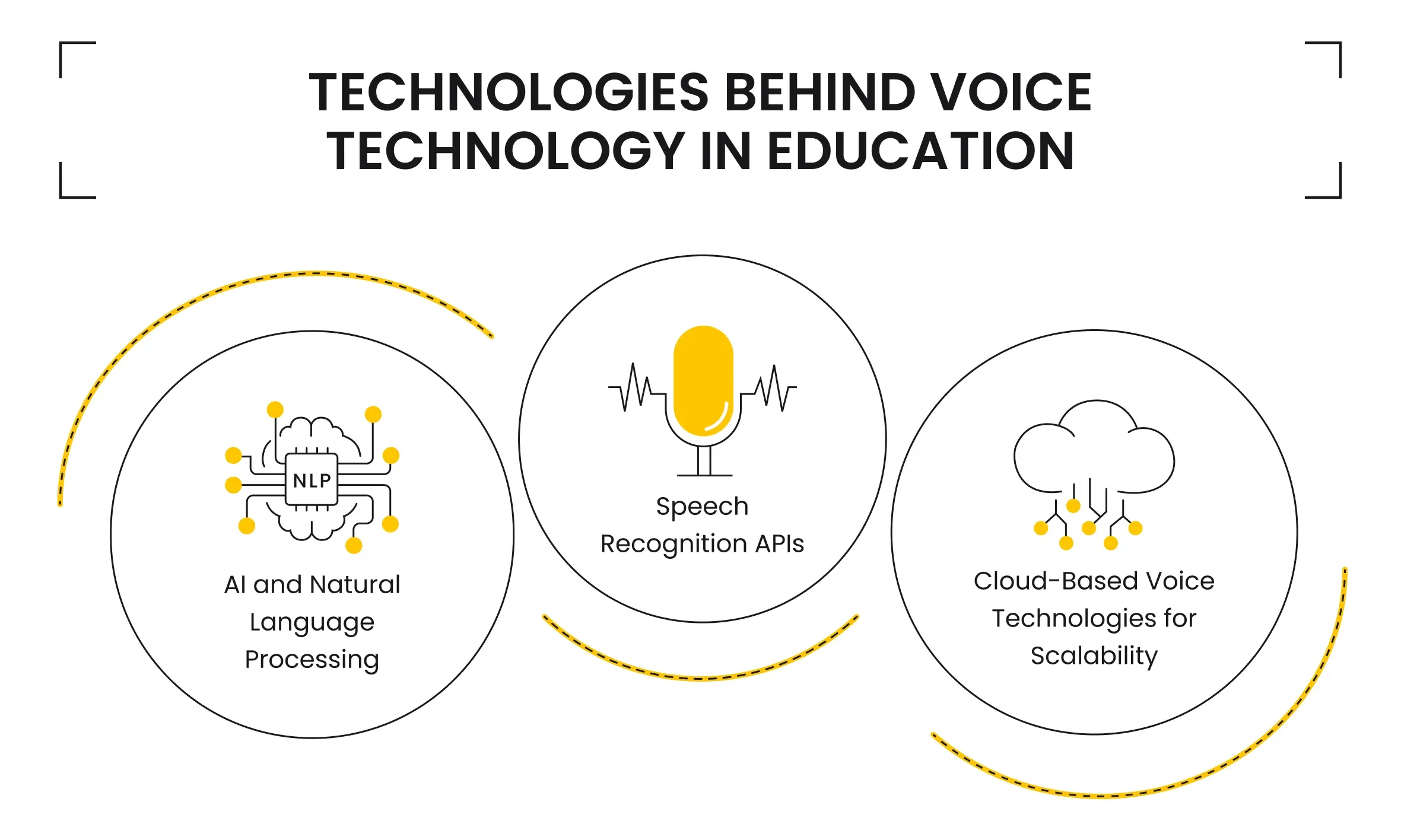
So, let’s briefly talk about the technologies behind voice technology in Education that enable such functionality in the first place.
Long story short, any voice AI technology is possible thanks to a few core tech solutions:
- AI and Natural Language Processing
- Speech Recognition APIs
- Cloud-Based Voice Technologies for Scalability
AI and Natural Language Processing
First and most apparent is artificial intelligence. Most modern, popular, and efficient AI solutions are based on Natural Language Processing models. This is a complex computation approach that uses a lot of data for training.
However, it is the core AI feature that allows the processing of human language and its specifics to correctly define the request, process it, and give a proper response. Nowadays, it is utilized in almost any type of AI, regardless of its kind, whether it is a chatbot or voice assistant.
Moreover, apart from ensuring the efficiency of your communication and interactions with AI, NLP allows particular customization. For instance, the previously mentioned Whisper AI can be fine-tuned, partly using NLP practices. Besides, using proper prompt engineering, you can make your virtual assistant behave or respond in a certain way.
Long story short, NLP-based AI models are more accurate and efficient and can use the data they were trained on to make them more personalized and tailor-suited.
One of the most surprising advantages of such software is that it requires almost no coding or software development experience. At least for some general and slight changes in its behavior. Nevertheless, you must learn how to write prompts and correctly operate AI to achieve proper results.
Speech Recognition APIs
Another essential technology you require to use voice technology in Education is speech recognition APIs.
Long story short, these are ready-made solutions that consist of algorithms and other practices used for voice recognition and its transcription into text. Breaking up the magic behind voice technologies, AI actually can’t understand voice commands. It operates text and, therefore, requires sound transcription.
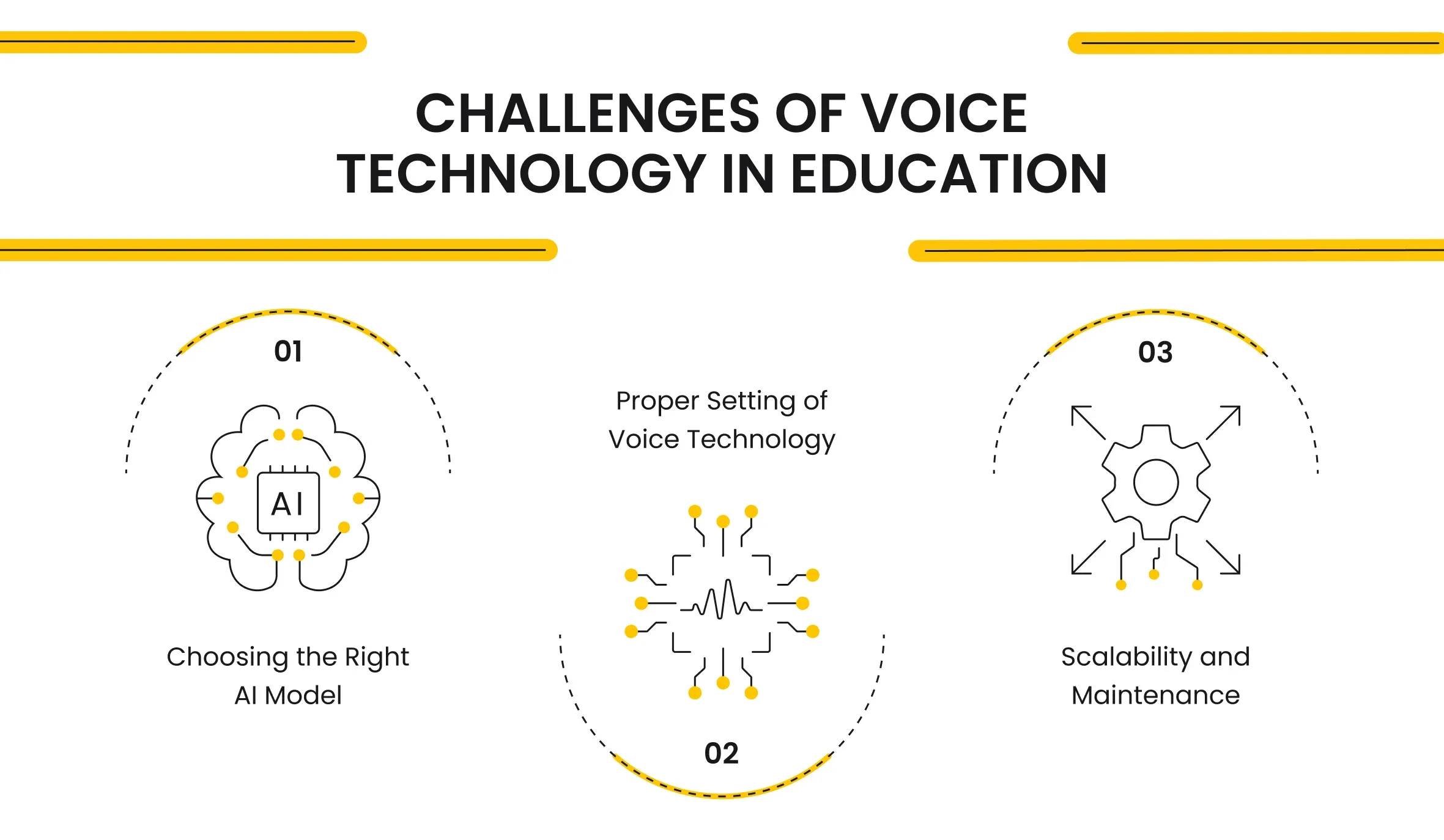
Creating such software from scratch is a very complex task requiring much time and resources. Fortunately, many software-as-a-service and third-party API solutions already exist and can be used as interpreters instead. Some of them, like Google Speech-to-text AI, cover the whole process, starting with voice recognition and speech transcription and ending with performing demanded requests.
Thus, you can choose between Whisper or Google Speech-to-Text solutions and integrate one. These software solutions can easily cover most of your requests and satisfy the demand.
Alternatively, connect a suitable speech-to-text transcription software with your artificial solution. However, you can’t develop a voice AI technology without integrating such solutions or creating your own version.
Cloud-Based Voice Technologies for Scalability
Finally, you must ensure the prospects for further scalability of your AI-based voice technology. As mentioned before, such solutions require a lot of data to process before becoming efficient. Besides, speech-to-text recognition demands a lot of resources for processing hours of audio.
One of the simplest, cost-efficient, and performative solutions is to choose cloud-based software. In such cases, you must find a reliable cloud services provider like Amazon or Google. You will also have to pay to use the cloud services, and you will be dependent on the internet connection.
Nevertheless, such services offer the best scalability options. They will be much cheaper in the short- and mid-term, allowing businesses to save costs on setting their servers and other infrastructure on-premises.
How to Get Started with Voice Technology Development?
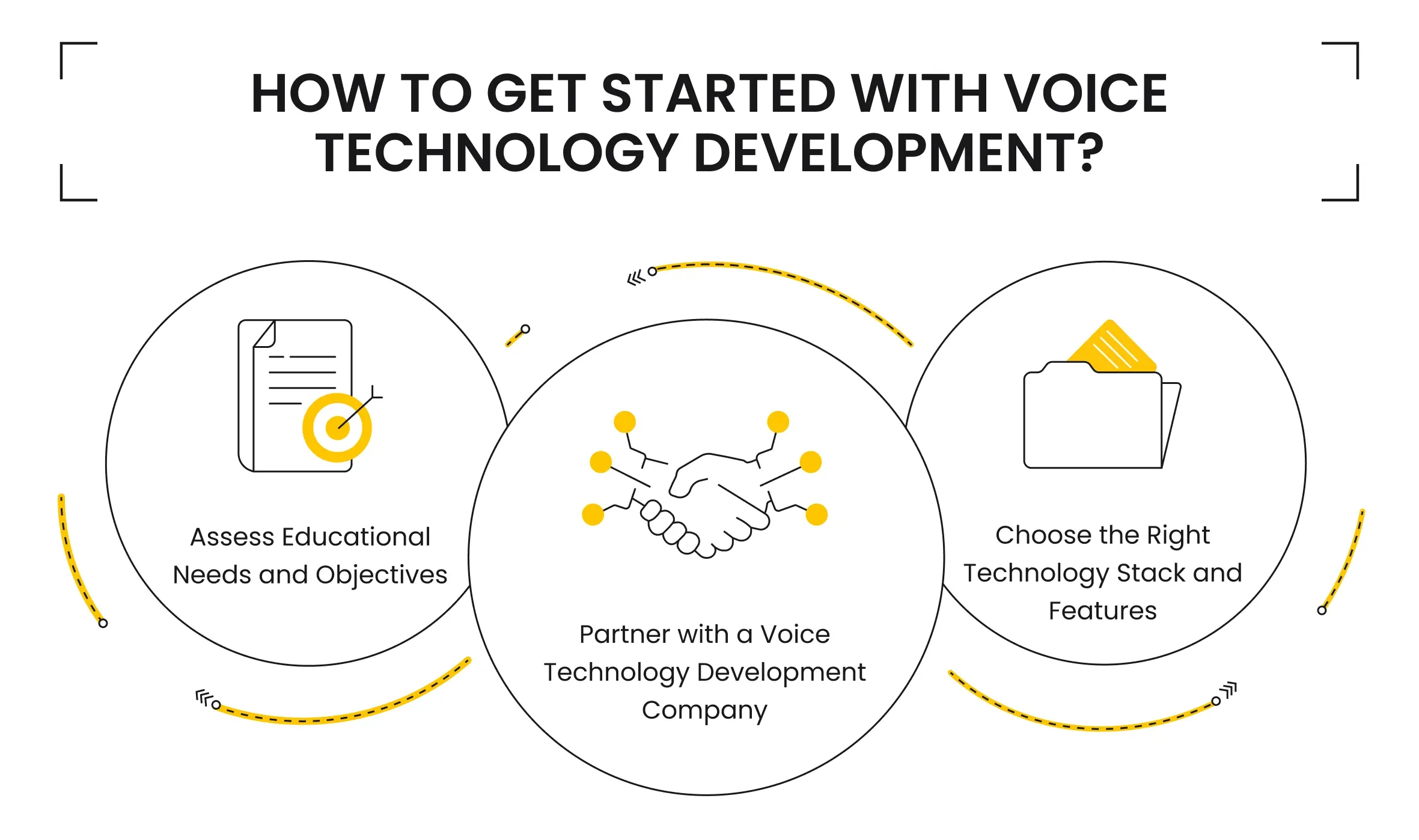
So, how do you get started with voice technology development and integration into your eLearning platform? In a nutshell, you have to take a few main steps:
- Assess Educational Needs and Objectives
- Partner with a Voice Technology Development Company
- Choose the Right Technology Stack and Features
Assessing Educational Needs and Objectives
Obviously, the first and most important step is to assess your needs and objectives, define how they can be satisfied with software solutions, decide whether it is justified or beneficial, and plan your software development and integration process.
When assessing your educational needs and objectives for voice technology in Education, you should ask yourself a few questions:
- Does it match your educational services?
- Is there a prioritized demand for such features?
- Will your users benefit and will use it regularly?
Matching Educational Services
First, you must clarify if you need voice AI technology. For instance, if it is a language learning platform, using voice technologies meets your target audience, offers unique features, and boosts your competitive advantage.
Conversely, if you are creating an online coding school, speech-to-text for students is a questionable investment.
Prioritized Demand for Voice Technologies
Another aspect is the users’ demand. Clearly, integrating new innovative features is a great and even must-have approach. Nevertheless, even in such cases, you shouldn’t forget the user’s demands and priorities.
To illustrate, scaling your software and integrating new features is excellent. However, if your current application version has a lot of bugs and errors, you should deal with these issues first.
Besides, you should constantly monitor and analyze your users and target audience. Maybe your TA expects totally different features and services. Thus, satisfying the core user requirement first will be much more beneficial for all parties than blindly following trends.
Benefits for the Users
Finally, you should consider what are the core benefits of speech-to-text technology in the classroom.
If you can’t come up with a list of at least 3-4 items - you should reconsider the whole idea of such integration. Otherwise, you can simply waste time and resources on delivering a feature that won’t be used by the users.
Partnering with a Voice Technology Development Company
Another step is to find a reliable voice technology development company, capable of delivering a demanded result.
The best way to find a proper tech partner is to examine B2B platforms like GoodFirms and Clutch. After creating a list of the most suited development teams, you should also learn their case studies and conduct interviews. For more details and step-by-step explanations, you can read our latest guide on how to hire the best custom software development team.
Choosing the Right Technology Stack and Features
Finally, you have to choose the right tech stack and features for your future voice AI technology. The best way to do so - is to discuss your ideas with the voice technology development company of your choice.
These companies have much more experience in dealing with such software; they know much more about various specifics and unpopular solutions. For example, you can contact us directly, and we will gladly discuss all of your ideas and find the most suitable solution just for you!
What’s your impression after reading this?
Love it!
1
Valuable
1
Exciting
1
Unsatisfied
1
FAQ
Let us address your doubts and clarify key points from the article for better understanding.
What are the challenges of integrating voice technology in education?
Integrating voice technology in education presents challenges such as speech recognition accuracy (especially for diverse accents and languages), privacy concerns with student data, potential distractions, accessibility for students with disabilities, and the need for teacher training to effectively implement the technology in learning environments.
What are the benefits of integrating voice technology into EdTech platforms?
Integrating voice technology into EdTech platforms enhances accessibility, enables hands-free interaction, supports language learning, provides personalized feedback, and improves engagement through interactive and conversational learning experiences.
Can voice assistants be integrated with existing EdTech platforms?
Yes, voice assistants can be integrated with existing EdTech platforms through APIs and SDKs, enabling features like voice navigation, interactive Q&A, personalized tutoring, and accessibility support for diverse learners.
Are there any cost considerations for implementing voice technology in education?
Yes, cost considerations for implementing voice technology in education include software development, licensing fees, hardware requirements, integration with existing systems, maintenance, and potential data privacy compliance expenses.
you may also like
Let’s talk!
This site uses cookies to improve your user experience. Read our Privacy Policy
Accept
Share this article